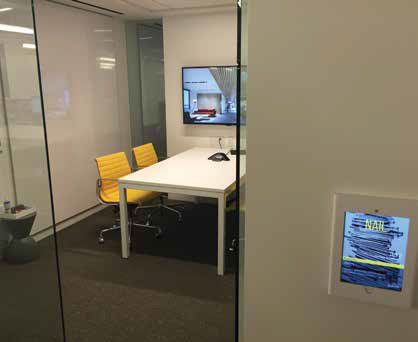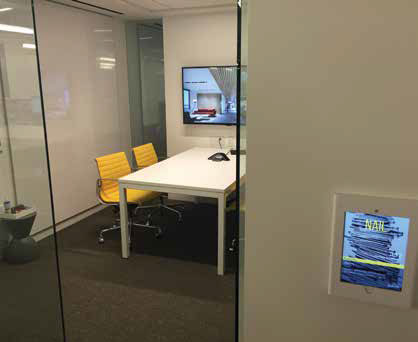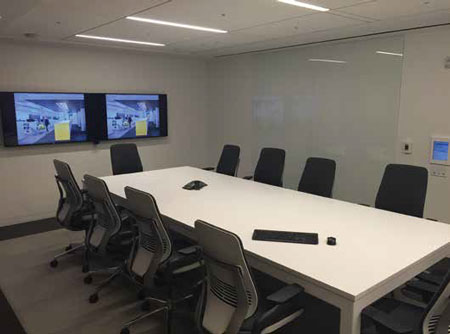IP-Based Control Enhances SF Office

When BCCI Construction Company prepared to move its San Francisco headquarters to a new office across town, it also sought a new AV setup with expanded functionality for the space. To accomplish this goal, BCCI opted for an IP-based AV system after weighing more traditional options.

BCCI Construction Company opted for an IP-based AV system for its new office in San Francisco. “We settled on the IP-based AV system mainly because it gives us the best flexibility as far as being able to route content across our eight conference rooms,” said Ken Chua, IT director for BCCI Construction Company. BCCI also liked the fact that the approach could take advantage of the company’s existing IP-based backbone. “We were attracted to the fact that it can just piggyback over our existing ethernet cable plant and infrastructure, including the switches and all that stuff,” Chua said.
Joey D’Angelo designed the project while he was a vice president at Charles M. Salter Associates (he now works as director of systems solutions for QSC). D’Angelo got the idea from a previous install using a networked setup that he’d worked on for Juniper Networks featuring nearly 350 conference rooms.
“All the audio, all the video, all the control at Jupiter Networks was entirely delivered, routed, processed, and administered and controlled via the network,” D’Angelo said. “But one of the things that we still couldn’t get away from when we did that job was that we still had to have a lot of control processors.”
With the BCCI installation, the need for separate individual control processors for each instance of AV was eliminated through the use of Utelogy’s software-based control platform. According to Frank Pellkofer, Utelogy co-founder and CEO, Utelogy has participated in numerous centralized AV-over-IT projects in the higher education space, but this was its first in a corporate environment.
“The job itself was a pivotal project in the AV industry because it’s something that had never been done before,” asserted D’Angelo. “It represents a new way of doing the corporate AV environment.”
The setting also demanded a somewhat more user-friendly interface than Utelogy had employed in its higher education applications. “There was a need in a corporate environment to have a look and a feel that’s a bit more elevated than you might normally get in an education environment,” Pellkofer said. “So from a GUI perspective, it’s really good looking and a good user experience.”
A daily selection of the top stories for AV integrators, resellers and consultants. Sign up below.
By eliminating the need for a separate set of infrastructure, the system also provided cost advantages. “I think that it was probably 30 to 50 percent cheaper than doing AV the traditional way,” D’Angelo said.
The server room features QSC products that include a Q-SYS Integrated Core, a Q-SYS I/O frame, and a Q-SYS CX204V 70-volt power amplifier. From the server room, which also has Apple TV and a Comcast cable box, the IT team can deliver content to various conference rooms directly—something that wasn’t possible in the old office without running cable to those rooms.

Seven of the conference rooms, as well as the kitchen area, feature LG 55SE3B 55-inch class LED displays, while the main conference room features an NEC PA521U projector and an electrically controlled widescreen. SVSi N1211 video-over-IP decoders were installed in each conference room, along with SVSi N1111 video-over-IP encoders in the main conference room and kitchen/pantry area. An iPad Air outfitted with the Utelogy software is bolted to the wall in each conference room. From the iPad, users can start up, shut down, and control the equipment.
Seven of the conference rooms, as well as the kitchen area, feature LG 55SE3B 55-inch class LED displays, while the main conference room features an NEC PA521U projector and an electrically controlled widescreen.
A divisible room and one other large conference room also feature microphone and speaker systems built into the ceiling, and incorporate phone-dialing capability into the system. “We can make a call through iPad rather than having a physical handset in the room,” Chua said. “That’s one more capability of the system that we’ve never had. Now, people can speak with a normal voice, and the microphones pick them up when they’re on a conference call.”
The new system also allows for much easier guest access to the displays for presenting via plug-andplay HDMI cables in each conference room.
The system’s expanded functionality has allowed BCCI to do things like hold large town hall meetings in the main conference room as some employees virtually attend in the other conference rooms. “Both audio and video content can be routed to these smaller conference rooms, so people don’t have to cram into the large conference room, but can still participate in the meeting,” Chua said.
The system also allows BCCI the future flexibility to plug AV devices in anywhere throughout their offices without added expense. As D’Angelo explained, “If they want to move a display over to a cubicle on the west side of their office, they can just unplug the display, roll it over, plug it into a network port there, and it instantly will start working.”
Chris Gelbach writes on diverse topics that include careers, marketing, the AV industry, and recreation management.
